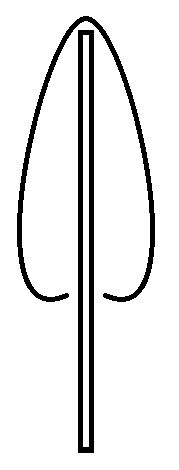Lilac (R4)

The fabric of these lilacs is a knitted mesh that allows glimpses of the interior green stem supporting the flower. The small bobbles are arranged in a square grid to mimic the individual four-petalled flowers found on real lilac blooms.
A printable version of this pattern is available.
You will need:
- lilac and green yarns (dk weight)
- covered wire
- gummed tape
- 4 x double ended knitting needles (3mm)
- tapestry needle
- scissors
- wire cutters
Pattern:
(A list of abbreviations is available.)
Bloom
Cast on 6 stitches in lilac and join into the round.
- Round 1: [yfwd, kb1] x 6 (12)
- Round 2: [kfb, kb1] x 6 (18)
In the next round we're going to create the holes. For each set of three stitches the first two are cast off and the third – now on the RH needle – is kept live. The is the process any time the pattern calls for small numbers of stitches to be cast off in succession, always reserve a stitch and begin the casting off process from the beginning.
- Round 3: [cast off 2] x 6 (6)
- Round 4: [yfwd, kb1] x 6 (12)
- Round 5: [kfb x 3, kb1] x 3 (21)
- Round 6: [{cast off 1} x 2, cast off 2] x 3 (9)
- Round 7: [yfwd, kb1] x 9 (18)
- Round 8: [kfb, kb1] x 9 (27)
- Round 9: [cast off 2] x 9 (9)
- Round 10: [yfwd, kb1] x 9 (18)
- Round 11: [{kfb, kb1} x 2, kfb x 2] x 3 (30)
- Round 12: [{cast off 2} x 2, {cast off 1} x 2] x 3 (12)
- Round 13: [yfwd, kb1] x 12 (24)
- Round 14: [kfb, kb1] x 12 (36)
- Round 15: [cast off 2] x 12 (12)
- Round 16: [yfwd, kb1] x 12 (24)
- Round 17: [kfb x 2, {kfb, kb1} x 3] x 3 (39)
- Round 18: [{cast off 1} x 2, {cast off 2} x 3] x 3 (15)
- Round 19: [yfwd, kb1] x 15 (30)
- Round 20: [kfb, kb1] x 15 (45)
- Round 21: [cast off 2] x 15 (15)
- Round 22: [yfwd, kb1] x 15 (30)
- Round 23: [{kfb, kb1} x 4, kfb x 2] x 3 (48)
- Round 24: [{cast off 2} x 4, {cast off 1} x 2] x 3 (18)
- Round 25: [yfwd, kb1] x 18 (36)
- Round 26: [kfb, kb1] x 18 (54)
- Round 27: [cast off 2] x 18 (18)
Repeat rounds 25 to 27 three more times, then repeat round 25 once more.
- Round 38: [kfb x 2, {kfb, kb1} x 8] x 2 (56)
- Round 39: [{cast off 1} x 2, {cast off 2} x 8] x 2 (20)
- Round 40: [yfwd, kb1] x 20 (40)
- Round 41: [kfb, kb1] x 20 (60)
- Round 42: [cast off 2] x 20 (20)
Repeat rounds 40 to 42 three more times.
- Round 52: [yfwd, k2togtbl] x 10 (20)
- Round 53: [kfb, kb1] x 10 (30)
- Round 54: [cast off 2] x 10 (10)
- Round 55: [yfwd, k2togtbl] x 5 (10)
Turn the lilac bloom inside out (it can be quite a tight fit). Cast off all stitches.
Stem
Cast on 5sts in green and then i-cord for approximately 20cm, measured when the knitting is being gently stretched. Cut the yarn, thread through all stitches and pull tight.
Making Up:
Cut a piece of wire the same length as the stretched stem and cover each end with the gummed tape. Insert this into the i-cord stem. Sew a few stitches back and forth across the ends of the knitting to fix the wire in place.

As in the cross section above, insert the knitting covered wire into the cone shaped bloom. Sew into place such that one end is at the tip of the cone and the base of the cone is slightly tucked under.
Notes:
Needle/Yarn Size
As with most ODDknit patterns the yarn and needle sizes in the "you will need" section are just a guide. Feel free to improvise with whatever needles and yarn you have lying around - that's half the fun!
<<< See more Flowers
© 2017 All desgins and images are copyright of ODDknit. If you enjoy the content of this website, please consider buying me a coffee at the link below.





